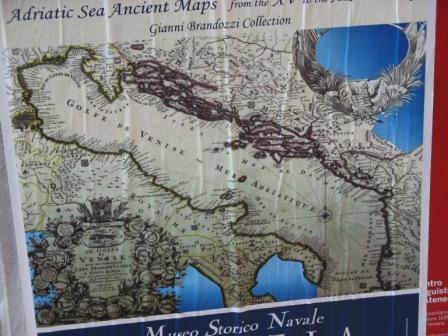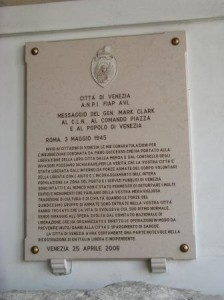 April 25 is a national holiday in Italy, but not because they’re all thinking of San Marco. It commemorates the liberation of Italy from the Nazi-Fascist regime in 1945, which was accomplished by, among other things, organized insurrections in major Italian cities aided by the advancing American and British armies.
April 25 is a national holiday in Italy, but not because they’re all thinking of San Marco. It commemorates the liberation of Italy from the Nazi-Fascist regime in 1945, which was accomplished by, among other things, organized insurrections in major Italian cities aided by the advancing American and British armies.
Lino was born in 1938, and he remembers the American troops arriving in Venice, and how he and all the other neighborhood kids ran to Piazzale Roma to see them and to score chewing gum and chocolate. He also remembers going with his school to the Piazza San Marco on April 25 that year to celebrate, along with what was probably every other school in the city. The Piazza was thronged with children, all the boys in short pants (like everybody else, Lino wore shorts, summer and winter –legs all chapped and red — till he was 14.)
Then all the children sang a patriotic Venetian song, “Torre degli avi,” which apostrophized the belltower of San Marco as the “tower of our ancestors.” Of course it sounds better in Italian, but I’ve approximated a translation. Quaint as this poetry may be, I try to read it imagining what it meant to everyone singing that day, all the children waving a little Italian flag.
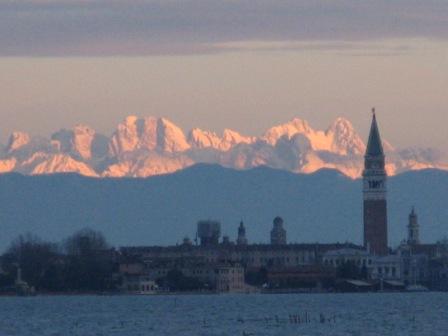 Torre degli avi, faro di gloria/ A te guardavano le antiche navi/Fiere lanciandosi sul nostro mar.
Torre degli avi, faro di gloria/ A te guardavano le antiche navi/Fiere lanciandosi sul nostro mar.
Torre degli avi che alla vittoria/Allor la bronzea voce prestavi/Risorgi e vigila sul nostro mar!
Dal campanile mite un augurio/Di pace effondesi nel ciel d’aprile/I bronzi squillano lieti nel sol.
Lo stuol gentile di messi argentei/Nel sole tiepido del ciel d’aprile/Di pace si libera a vol.
Viva San Marco! Del ciel d’Italia/Risorgi a gloria del campanile/Faro e segnacolo sul nostro mar.
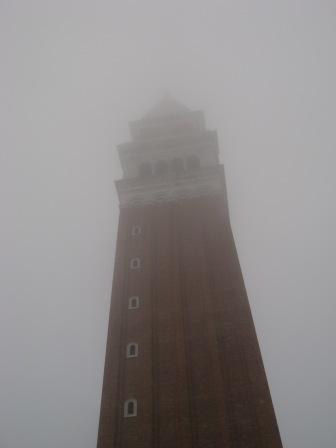 Tower of our ancestors, beacon of glory/The ancient ships looked to you/As they launched themselves proudly over our sea.
Tower of our ancestors, beacon of glory/The ancient ships looked to you/As they launched themselves proudly over our sea.
Tower of our ancestors, which to victory/Lent its bronze voice/Rise up and keep watch over our sea.
From the gentle belltower an augury/Of peace pours out in the April sky,/The bronze rings joyously in the sun.
The throng of silvery messengers/Free themselves to fly/In the warm sun of the April sky of liberty.
Long live San Marco! In the sky of Italy/Rise again to the glory of the belltower/Beacon and ensign over our sea.
The references to “our sea” aren’t an opinion, by the way; for centuries the upper Adriatic Sea was often called the Gulf of Venice. This poster showing an undated French map is a good example:
Speaking of World War 2, I came across a plaque the other day which Lino had never seen. Maybe these things just interest me more than they do him, but then again, it’s only been up for four years. It’s on the right-hand wall by the main entrance to Ca’ Farsetti, which is City Hall. An excellent place for memorials, and there are several others. Note: The C.L.N. was the National Liberation Committee, which organized the uprisings in 1945. (Translation by me.)
A.N.P.I.[NATIONAL ASSOCIATION OF ITALIAN PARTISANS]
FIAP [ITALIAN FEDERATION OF PARTISANS ASSOCIATIONS]
AVL [ASSOCIATION OF VOLUNTEERS OF LIBERTY]
MESSAGE OF GEN. MARK CLARK
TO THE C.L.N., THE AREA COMMAND
AND THE PEOPLE OF VENICE
ROME, MAY 3, 1945
I SEND MY CONGRATULATIONS TO THE CITIZENS OF VENICE FOR THE INSURRECTION COORDINATED WITH COMPLETE SUCCESS WHICH HAS BROUGHT THEIR CITY LIBERATION FROM THE GRIP AND CONTROL OF THE INVADERS. WE CAN DECLARE THAT TRULY YOUR CITY HAS BEEN LIBERATED FROM WITHIN BY ARMED FORCES OF THE VOLUNTEER CORPS OF FREEDOM AND WITH THE HELP AND ENCOURAGEMENT OF THE ENTIRE POPULATION. THE PORT AND THE PUBLIC SERVICES OF VENICE ARE INTACT AND THE ENEMY WAS NOT PERMITTED TO DEFACE THE MANY BUILDINGS AND MONUMENTS WHICH SPEAK OF YOUR MARVELOUS TRADITION OF CULTURE AND CIVILIZATION. WHEN THE FORCES OF THE FIFTEENTH GROUP OF THE ARMY ENTERED YOUR CITY THEY FOUND THAT LIFE WAS BEING CARRIED OUT IN ITS NORMAL RHYTHM. I RENDER HOMAGE TO THE WORK ACCOMPLISHED BY THE NATIONAL LIBERATION COMMITTEE WHICH ORGANIZED AND DIRECTED THE OPERATIONS IN SUCH A WAY AS TO PREVENT USELESS DAMAGE TO THE CITY AND THE SHEDDING OF BLOOD.
THE CITY OF VENICE WILL SURELY HAVE A NOTABLE PART IN THE RECONSTRUCTION OF A FREE AND INDEPENDENT ITALY.
I could go on for quite some time, long after you’ve gone to bed, but I’ll stop just now with one more thing. There is a series of plaques, each affixed near a bridge, which recall the fate of each individual who was the victim of a particular episode of partisan resistance to the Nazis. Eventually I will track down the details of this episode; meanwhile, I can say that the text is always the same, though the name changes, of course. I find its simplicity very moving. Of course, people being killed for freedom is always moving, but the expression itself is lovely.
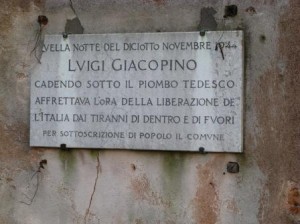
By subscription of the people, the Commune
I am not especially interested in military history, as such, but here in Venice these exploits take on a strangely personal aspect. It may be because the city is so small. In any case, if you calibrate your vision to notice these things, you’ll come away from a walk around Venice with the sensation of having spent the day in the world’s most beautiful war museum. Almost against my will, I have become moderately obsessed with these assorted memorials, and the complexity of the events they recall. Rudimentary as my knowledge may still be, they too have become part of my personal Venice.
The glamor of Renaissance Venice — doges! admirals! lots of fancy costumes! — has obscured the twentieth century from general interest, but it is a period which I have come to realize is just as rich and poignant and desperate as anything from the glory days of the Venetian Republic. Both world wars left all sorts of scars here, not mention relics of the failed uprising of 1848 against the Austrian occupation and assorted other depredations. So while your taste may not run to cannonballs and unexploded bombs, I’m going to be showing them to you anyway, from time to time. Venice deserves admiration, not only for its splendor and power and daring and all those things that make us feel so swell, but also for its suffering and its endurance. You’ll be amazed there’s any city left standing, once you start looking around, even if all that happened before the tourist onslaught turned Venice into another kind of battleground.

